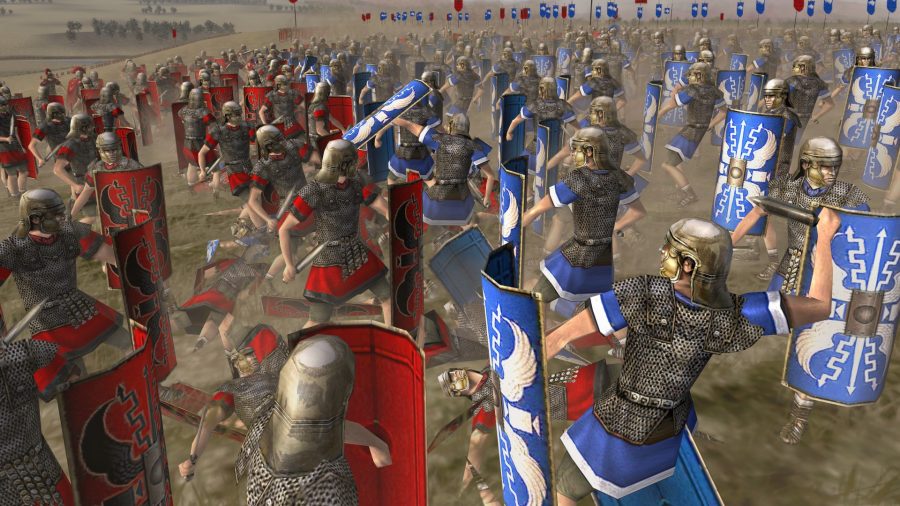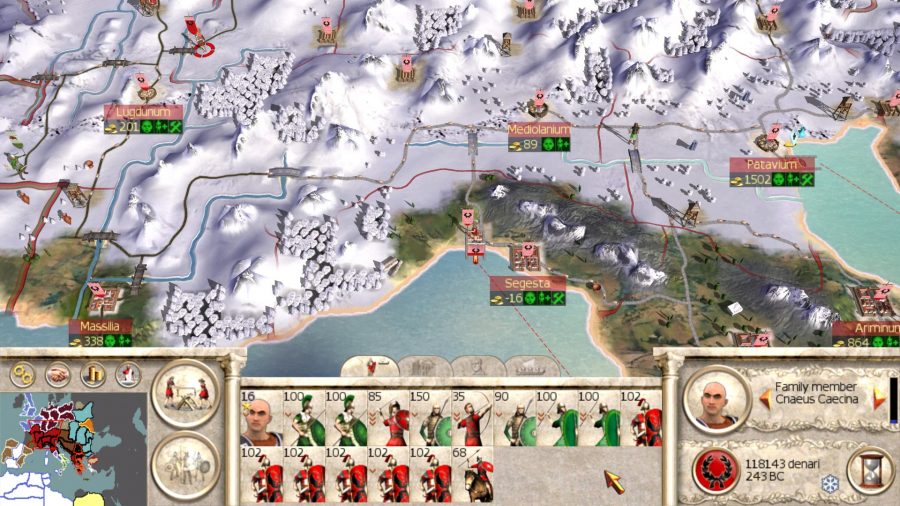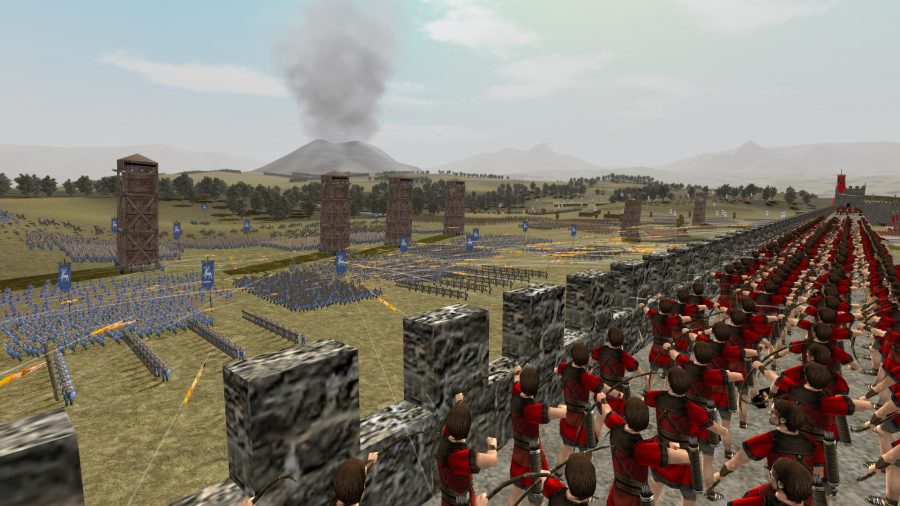Total War: ROME: The Board Game is an ambitious, large-scale strategy board game adaptation of the classic 2004 PC strategy game from developer Creative Assembly (CA) and publisher SEGA. We’re big fans of the Total War games, so we were positively gibbering with excitement when we exclusively revealed the Rome: Total War board game back in August. Now we’re starting to learn a bit more, we can bring you our guide to everything we know about Total War: ROME: The Board Game.
The game is being produced and published by the UK-based firm Plastic Soldier Company (PSC), in close cooperation with CA and SEGA – and Wargamer’s been able to glean quite a few juicy details about its development since our initial reveal article, including via exclusive interviews with the game’s principal designer, Simon Hall.
If you’ve got a hankering to lead your faction to victorious conquest across the ancient world, make sure you bookmark this guide, and keep checking Wargamer’s news – because we’ll be excitedly reporting every crumb of new information on Total War: ROME: The Board Game as it comes to us.
Here’s everything you need to know about the upcoming board game:
- Total War: ROME: The Board Game release date
- Total War: ROME: The Board Game trailer
- Total War: ROME: The Board Game map
- Total War: ROME: The Board Game factions
- Total War: ROME: The Board Game gameplay
- Total War: ROME: The Board Game expansions
- Total War: ROME: The Board Game solo modes
Total War: ROME: The Board Game release date
As yet, there is no confirmed Total War: ROME: The Board Game release date or release window. However, a final crowdfunding launch date has been announced: PSC Games says the Gamefound campaign will launch on January 20, 2022.
Shortly before the originally planned launch date of November 30, PSC delayed the crowdfunding campaign until January 17, 2022. Then, on January 14, it announced in an email update that the big day would now be Thursday, January 20.
Official timescale estimates will have to wait for the campaign to go live – but, judging by similar crowdfunded projects, would-be backers might reasonably expect to receive their copies by the end of 2022, or early 2023.
The game’s Gamefound crowdfunding page first appeared on September 20, with placeholder content to encourage fans to sign up for updates. It included the following preview description:
Based on the world-renowned video game, Total War: ROME: The Board Game allows up to four players to play as the leaders of Rome, Carthage, Greece, and Gallo-Germania. Each player will claim territories, recruit armies, fight enemies, raise taxes, spy, riot, and more.
We first reported that Total War: ROME: The Board Game was coming on August 3, 2021, and PSC officially announced the game a week later on August 10.
We are extremely happy to announce that we are teaming up with @SEGA and @CAGames to create a board game based on the world-renowned video game, @totalwar: ROME. Sign up to the Total War: Rome: The Board Game e-mail list to find out more – https://t.co/nEzgfmNzTF pic.twitter.com/vhFoyc2H2y
— PSC Games (@PSCGamesUK) August 10, 2021
We’ll keep you updated with any changes to the game’s release timetable as soon as we hear about them.
TOTAL WAR: ROME: THE BOARD GAME TRAILER
In a January 14 update, PSC Games released a 45-second-long, animated “short trailer” for the game. It features a Roman leader surveying military positions on a map, with a voiceover describing desperate conditions, enemies on all sides, diplomatic uncertainty, and the promise of military glory. Here it is:

At the end of the “short trailer”, PSC restates the new Gamefound launch date of January 20, alongside the familiar mock-up of the game’s box art.
Total War: ROME: The Board Game map
Ahead of the game’s crowdfunding launch in late November 2021, PSC games revealed our first look at ROME’s full game map, including borders, provinces, and even, in one image, a limited ‘legend’ explaining some of the map’s key markings.
The game’s map will use a variety of symbols to indicate regions with special terrain, like mountains or forest, that can either hinder or bolster certain types of troops’ effectiveness when fighting there.
We can also see that the game’s ancient world is split into provinces, which each have a tax value (in millions of Denarii) that you’ll add to your income by controlling that territory.
Anchor symbols, meanwhile, denote the harbours you’ll need to use to embark your armies by sea (oh, and yes – naval combat is confirmed to be included in the game – though we’ve no hard details yet on how it’ll work).
PSC games stresses this map artwork isn’t final, and could go through some changes during development (which is still very much ongoing). We expect to see a few more teasers of the board and other components in the run-up to the Gamefound crowdfunding launch on November 30.
Total War: Rome: The Board Game factions
Total War: ROME: The Board Game’s base box will come with four playable factions: Rome, Greece, Carthage, and the Gallo-Germanic Barbarian Tribes.
However, as we reported on September 16, this roster can be expanded by picking up some of the planned ‘Army Pack’ expansions.
The game’s designer, Simon Hall, tells us he expects eight of these packs to be available when ROME launches for crowdfunding at the beginning of 2022, including the Numidians, Persians, Thracians, Macedonians, Scythians, and Spanish.
Therefore, the currently confirmed Total War: ROME: The Board Game factions are:
- Rome
- Greece
- Carthage
- Barbarian Tribes / Gallo-Germania
- Numidia
- Persia
- Thrace
- Macedonia
- Scythia
- Spain
Total War: ROME: The Board Game gameplay
Head of PSC Will Townshend describes Total War: ROME: The Board Game as “an empire-building wargame with an economic engine”, and its stated aim is to translate all the most important features of the PC strategy game into tabletop form.
The game’s emphasis, says Townshend, is on “building armies and beating the shit out of your opponents”. In the process, he says, you’ll be “throwing lots of dice, building your armies, upgrading, and all that stuff that you do in the videogame”.
According to designer Simon Hall, a full game with four players typically takes six or seven turns to complete – with a playtime under three hours. This can expand to more like a five-hour playtime once you add in extra factions from the Army Pack expansions, which expand the maximum player count to eight.
Battles are played using decks of cards in two-player, head-to-head matches. Each player assembles a stack of units, before taking turns rolling dice to perform attacks. Hall says combat has been designed to be quick (taking around two to three minutes) but still strategically deep, as unit choice and terrain will play a big tactical role.
If you love the original videogame for its intricate RTS battles, however, don’t worry. Read the details of the ‘BattlePlay’ expansion below to find out how the board game will replicate real-time tactics on the tabletop.
When it comes to other nitty-gritty details – how the economy and upgrades work, we’re still in the dark for now. But rest assured, we’ll keep you updated as soon as we get more insights into the ROME’s gameplay mechanics.
Total War: Rome: The Board Game expansions
Early on, Simon Hall and PSC confirmed two types of expansion to be in development for Total War: ROME: The Board Game. These are Army Pack expansions, each of which we know will contain (at minimum) a player board, and a “pack of troops” to represent its given faction; and Map expansions, which introduce more regions to the board game’s overall playable area, providing more real estate for historical conflicts.
The Total War: ROME: The Board Game expansions so far confirmed to be in development or discussions are:
- Army Pack: Numidians
- Army Pack: Persians
- Army Pack: Thracians
- Army Pack: Macedonians
- Army Pack: Scythians
- Army Pack: Spanish
- Map expansion: Greece
- Map expansion: Britannia
- Map expansion: ‘Barbarian Edition’ – depicting the Western and Eastern Roman Empires
Hall did tell us the game was particularly well adapted to have expansions appended to it:
“The game system that I’ve developed is completely modularized and flexible…so it’s very, very easy to do the expansion packs for a bunch of minor nations to add to the main ones.”
And, after a fan-base poll held on the Gamefound preview page in December 2021 to decide between an Alexander The Great-themed expansion or a “Barbarian Invasion” expansion, PSC revealed that Alexander had won by 730 votes to 522 – meaning the Alexander Expansion will reportedly be developed and manufactured alongside the main game after crowdfunding is complete. Per the Gamefound update:
“The Alexander Expansion will give players access to a brand new large map to conquer, with a focus on the east. There will be additional factions to play, such as Macedon, India and Persia, complete with factions boards, miniatures, and more.”
On top of that, the board game will release alongside a ‘BattlePlay’ expansion that’s intended to replicate the videogame’s real-time tactical battles. Adding an additional ‘battleboard’ that allows for more intricate combat scenarios, Hall says it will expand the game’s fighting into a “mini tabletop wargame”.
You’ll be arranging your troops across the battleboard, before taking turns launching attacks and using the modular terrain to your advantage. It’s also driven by card-play, and is based on another of Hall’s games: Mortem Et Gloriam, a fully-fledged tabletop wargame ruleset.
TOTAL WAR: ROME: THE BOARD GAME Solo modes
Hall also confirmed to Wargamer that Total War: ROME: The Board Game will feature two solo modes, letting you play the entire game single player as any nation on the map.
The two modes differ in complexity. In the simpler solo mode, opposing territories acts passively. They won’t move on the board, or actively invade other nations. They’ll only reactively attack when you attempt to invade their borders. Smaller regions will boast stronger forces, while smaller territories will have weaker garrisons to contend with.
In the more complex solo mode, opposing players are simulated through a card system. The system replicates the mechanics of a multiplayer game, so you’ll be drawing cards on behalf of your opponents and resolving their actions. Hall says you’ll be drawing cards for your opponents and dealing with them immediately, so you won’t have any hand management or card memorisation to factor in.












